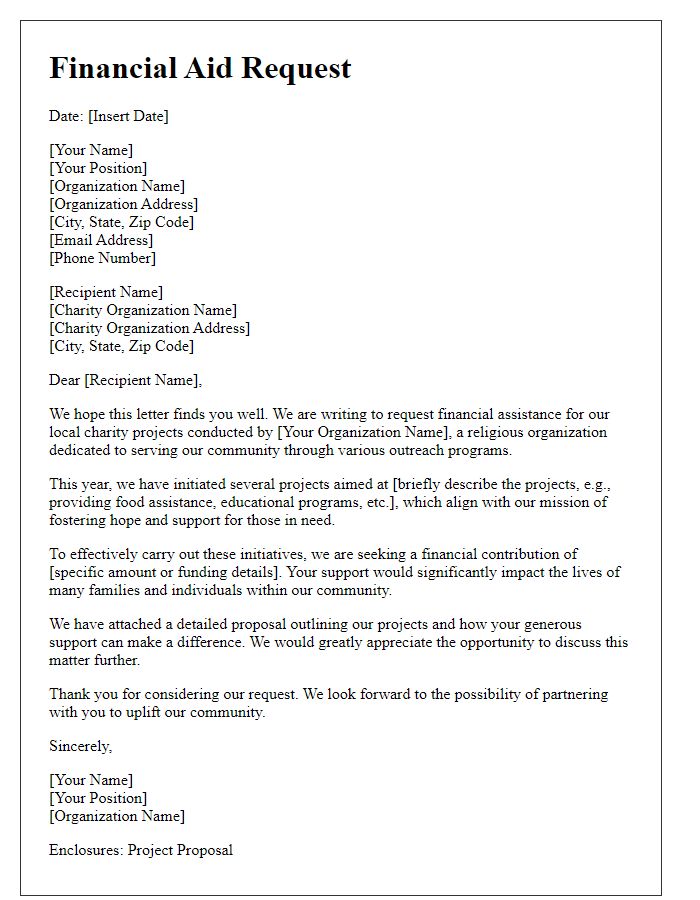Are you looking to secure funding for your religious institution? Crafting a compelling grant application is key to showcasing the impactful work your organization does. In this article, we'll walk you through an effective letter template designed specifically for religious institutions seeking grants. Join us as we explore tips and strategies to strengthen your application and increase your chances of success!

Introduction and Mission Statement
A community outreach program, run by St. Mark's Catholic Church in Springfield, seeks funding to enhance local support for families in need. Established in 1985, St. Mark's aims to serve God and foster spiritual growth while addressing the practical needs of underserved populations. This initiative aligns with our mission of compassion, emphasizing values such as charity, service, and social justice. Currently, the program assists over 300 families annually, offering food assistance, clothing donations, and counseling services. This grant will enable us to expand our reach, implement educational workshops, and collaborate with local organizations to create a sustainable impact in the community.
Project Description and Objectives
A grant application for a religious institution project often emphasizes community support, outreach, and spiritual development within a specific context. The initiative aims to enhance the well-being of local families by offering faith-based activities, educational programs, and social services. This project anticipates reaching approximately 200 participants within the first year, focusing on individuals from low-income neighborhoods in [City Name]. Key objectives include establishing a weekly food pantry operated by volunteers from the community, organizing monthly workshops on financial literacy and wellness, and creating a mentorship program for youth to foster personal growth and leadership skills. Through these initiatives, the project seeks to cultivate a supportive environment rooted in compassion and service, reinforcing the institution's mission to serve both spiritually and materially those in need.
Budget and Financial Plan
A comprehensive budget and financial plan for the grant application of a religious institution, such as a church or a synagogue, must clearly outline the intended use of funds. This plan typically includes specific line items such as operational costs (including utilities, property maintenance, and salaries), outreach programs (funds allocated for community services and charitable initiatives), youth engagement activities (budget for events aimed at attracting younger members), and facility improvements (renovation costs for worship spaces). Accurate estimations should reflect local economic conditions, such as average costs of living or regional donations per capita, to enhance financial viability. Additionally, potential income sources, including tithes, fundraising events, and grants from related organizations, must be itemized, demonstrating the institution's financial sustainability and commitment to fulfilling its mission within the community.
Impact and Community Benefits
Religious institutions such as churches, synagogues, and mosques play vital roles in their communities, providing essential services, spiritual support, and fostering social cohesion. Programs focused on outreach, education, and disaster relief can significantly enhance community resilience and well-being. For example, a church's food pantry can serve over 500 families monthly, addressing food insecurity in urban areas, while educational workshops on financial literacy empower community members with valuable skills. Engagement in community clean-up events not only beautifies neighborhoods but also fosters a sense of belonging among diverse populations. In times of crisis, such as natural disasters, religious organizations often mobilize resources and volunteers, offering immediate assistance and long-term recovery support. Establishing youth mentorship programs within a religious setting can cultivate leadership skills and create positive role models, making a lasting impact on the younger generation. Thus, funding for these initiatives can drive social change and uplift entire communities, demonstrating the profound influence of faith-based organizations.
Supporting Documentation and Credentials
Supporting documentation and credentials play a pivotal role in establishing the credibility of religious institutions seeking grants. Certificates of incorporation (such as 501(c)(3) status in the United States) demonstrate nonprofit compliance and tax-exempt status, strengthening the application. Financial statements, including balance sheets and income statements from the previous three fiscal years, provide transparency regarding fiscal health. Project proposals must outline specific programs (such as community outreach initiatives or educational classes) to showcase intention and impact. Letters of support from local community leaders, such as mayors or school principals, validate the institution's community involvement and respect. Finally, testimonials from beneficiaries (like individuals who have received support) illustrate the institution's positive impact, reinforcing the need for grant assistance to expand or enhance services provided.
Letter Template For Religious Institution Grant Application Samples
Letter template of grant request for religious community outreach program

Letter template of funding proposal for faith-based educational initiative

Letter template of financial support application for church renovation project

Letter template of funding request for religious youth mentorship program

Letter template of financial aid request for local charity projects by a religious organization

Letter template of grant proposal for health and wellness programs at a place of worship

Letter template of funding application for community service projects sponsored by a religious group

Letter template of grant application for religious arts and cultural programs






Comments